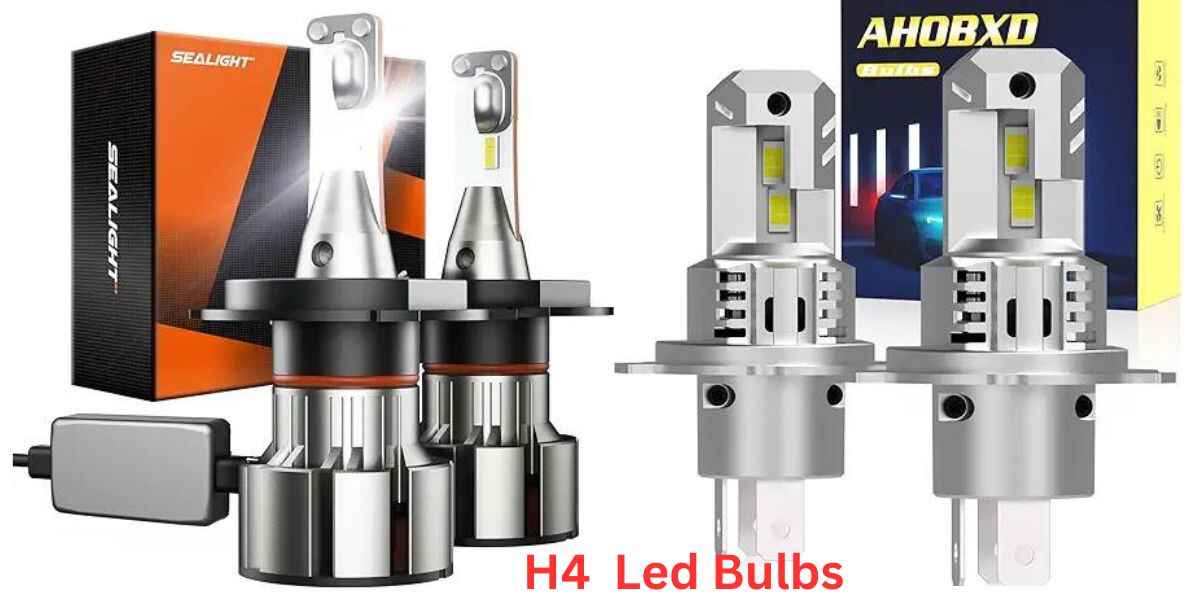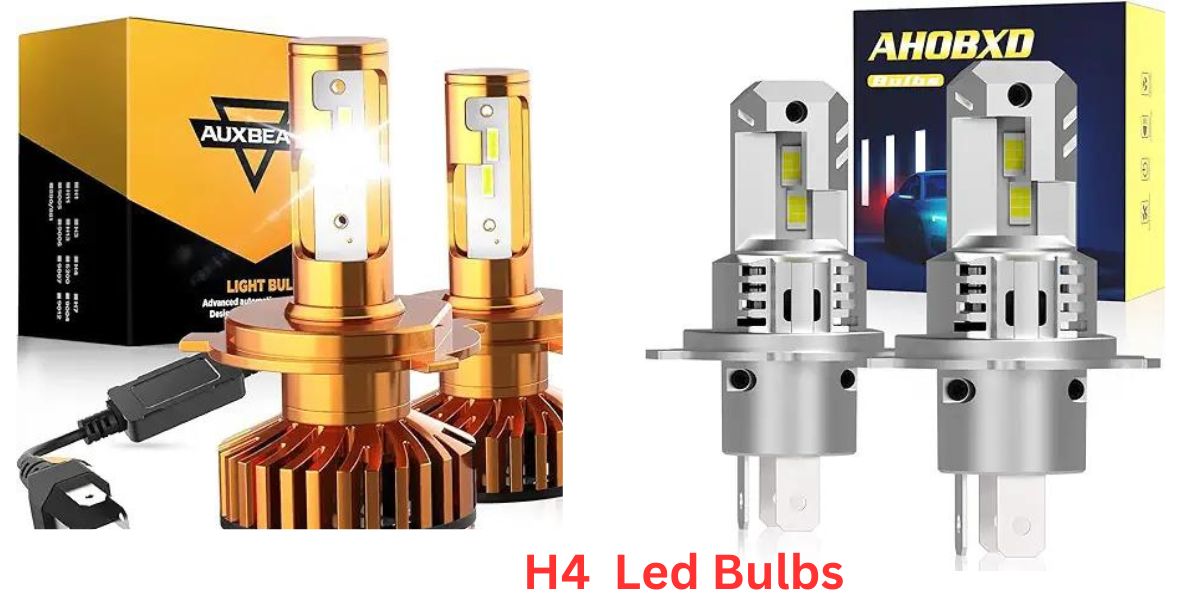When it comes to vehicle lighting, selecting the right bulb is crucial for safety and performance. H4 and H13 bulbs are widely used in various types of vehicles, including cars, trucks, and motorcycles. Understanding the difference between H4 and H13 bulbs can help you make an informed decision about which one is best for your needs. This article explores the key distinctions between H4 and H13 bulbs, their applications, and how to choose the right fit for your vehicle.

What Are H4 Bulbs?
H4 bulbs are a type of halogen bulb often used in headlights. These bulbs have a dual filament design, providing both high and low beams, which makes them versatile for multiple vehicle types.
Features of H4 Bulbs
- Dual Filament: H4 bulbs include separate filaments for low and high beams, making it easy to switch without needing separate bulbs.
- Brightness: These bulbs produce between 1,000 and 1,500 lumens, adequate for most driving conditions. The H4 halogen bulb lumens provide decent visibility.
- Compatibility: H4 bulbs fit a wide variety of vehicles, especially older models and motorcycles.
Advantages of H4 Bulbs
- Versatility: The dual filament design is ideal for both high and low beam use.
- Availability: H4 bulbs are widely available at most auto parts stores.
- Cost-Effective: These bulbs offer good value for money, making them a popular choice for budget-conscious buyers.
Disadvantages of H4 Bulbs
- Heat Production: Halogen bulbs like the H4 can generate significant heat, potentially reducing lifespan.
- Energy Consumption: H4 bulbs consume more power compared to LED or HID bulbs.
What Are H13 Bulbs?
H13 bulbs also known as 9008 bulbs, are another type of headlight bulb commonly found in newer vehicles. These bulbs also have a dual filament design, enabling both high and low beams.
Features of H13 Bulbs
- Dual Filament: H13 bulbs feature dual filaments for high and low beams, similar to H4 bulbs.
- Brightness: H13 bulbs produce between 1,500 and 1,800 lumens, which is slightly higher than H4 bulbs, making them better for low-light conditions.
- Compatibility: H13 headlight bulbs fit newer vehicle models and are often incompatible with older models.
Advantages of H13 Bulbs
- Brightness: The higher lumen output of H13 bulbs provides improved visibility, particularly in dim lighting.
- Durability: H13 bulbs are typically more durable and have a longer lifespan.
- Energy Efficiency: These bulbs are more energy-efficient, delivering more light while using less power.
Disadvantages of H13 Bulbs
- Compatibility: Older vehicle models may not support H13 bulbs.
- Cost: H13 bulbs are generally pricier than H4 bulbs.
 Key Differences Between H4 and H13 Bulbs
Key Differences Between H4 and H13 Bulbs
Now that we have an understanding of H4 and H13 bulbs, let’s dive into the differences to clarify what each offers.
1. Filament Design
Both H4 and H13 bulbs have dual filament designs, yet their applications vary. H4 bulbs are common in motorcycles and older cars, while H13 bulbs are typically found in newer cars and trucks.
2. Brightness and Lumens
When considering brightness, H4 bulbs produce 1,000 to 1,500 lumens, while H13 bulbs range from 1,500 to 1,800 lumens. This higher output in H13 bulbs makes them suitable for low-light driving conditions.
3. Compatibility
H4 bulbs are widely compatible with older vehicle models, while H13 bulbs are often used in newer vehicles. What cars are compatible with H13 headlight bulbs, in case you were wondering?” it’s usually newer car models, while H4 bulbs may better fit motorcycles or older cars.
4. Energy Efficiency
H13 bulbs consume less energy than H4 bulbs, which helps extend their lifespan. This efficiency may make H13 headlight bulbs a better option if you prioritize energy savings.
5. Cost
Generally, H4 bulbs are more affordable, while H13 bulbs may come at a higher price but offer greater durability and brightness.
Common Comparisons: H13 vs. H11, H3, and H7 Bulbs
If you’re comparing options, it’s essential to understand where H13 stands against other popular headlight bulbs like H11 and H7.
- H13 vs. H11 Bulbs: One of the main differences between H11 and H13 bulbs is the compatibility with newer car models. H11 bulbs are usually lower in brightness and better suited for fog lights, while H13 bulbs work as primary headlights.
- Difference Between H3 and H4 Bulbs: H4 bulbs are headlight options with dual filaments, whereas H3 bulbs typically serve as auxiliary lights. Knowing the difference between H3 and H4 bulbs can help you choose the right fit for specific lighting needs.
- H13 vs. H7 Bulbs: If you’re comparing H13 and H7 bulbs, note that H7 bulbs are single filament, so they’re typically used only in high or low beams, unlike the dual filament H13.
Which Bulb Is Right for Your Vehicle?
Choosing between H4 and H13 bulbs depends on factors like vehicle model, typical driving conditions, and budget.
Consider Your Vehicle Model
If you have an older car or motorcycle, H4 bulbs are more likely to fit. For newer vehicles, H13 headlight bulbs may be a better option. Be sure to check your car’s manual for specifications, as it can clarify what vehicle does H13 bulb fit and whether H13 headlight bulbs are compatible.
Assess Driving Conditions
If you drive often on dimly lit roads, the higher brightness of H13 bulbs may enhance safety. However, H4 bulbs are sufficient for standard driving conditions.
Budget Considerations
If cost is a concern, H4 bulbs are generally more affordable, making them a good option for budget-friendly replacements. If you prefer brighter, more durable lighting, investing in H13 bulbs might be worthwhile.
Conclusion
In summary, H4 and H13 bulbs each have their own benefits and drawbacks. H4 bulbs offer versatility, broad compatibility, and affordability, making them suitable for many vehicles. H13 bulbs, on the other hand, provide higher brightness, energy efficiency, and a longer lifespan, making them ideal for newer cars and low-light driving.
When deciding between H4 and H13 bulbs, consider factors such as your vehicle model, driving conditions, and budget. Understanding the differences between H4 and H13 bulbs ensures you make an informed choice that optimizes your vehicle’s lighting for safety and performance.
Read also:
Hi, I’m Malik Suhail—an SEO expert, web designer, and passionate blogger with 2 years of experience. I specialize in crafting content that is not only informative but also tailored to meet the needs of my readers.
I write about diverse topics, always striving to simplify complex ideas and provide valuable insights that resonate with my audience. Whether it’s about SEO strategies, web design trends, or blogging tips, I am committed to delivering well-researched, practical, and easy-to-understand information.
My mission is to help readers navigate the digital world with confidence and clarity. I believe in adding value through authentic content that inspires action and delivers results.


